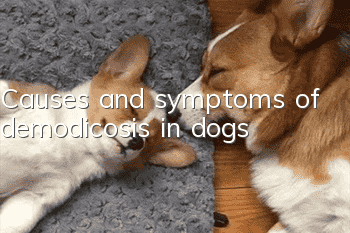Causes and symptoms of demodicosis in dogs

You have ten years, his life! Love dogs, love life!
Canine demodectic mange is also called trichocystis or lipid mange. It is a common and stubborn dog skin disease caused by Demodex canis parasitizing sebaceous glands or hair follicles. It mostly occurs in puppies aged 5-10 months.
1. The causes of canine demodicosis:
1. Canine Demodex is translucent and milky white, with a long and narrow body like a worm, with a body length of 0.25-0.3 mm and a width of about 0.04 mm. It can be divided into three parts: front, middle and back.
2. All the development processes of Demodex canis are carried out on the dog body, including eggs, larvae, nymphs, and adults. Among them, nymphs have three stages.
3. Most of the canine Demodex mites parasitize in the upper part of the hair follicles of the affected skin, and then move to the bottom, and rarely parasitize in the sebaceous glands. In addition, in addition to parasitizing hair follicles, they can also live in dog tissues and lymph nodes, and some of them reproduce in them.
2. Clinical symptoms of canine demodicosis:
Canine Demodex symptoms can be divided into two types:
1. Scaly type: It usually occurs in and around the eyelids, corners of the mouth, forehead, nose, lower part of the neck, elbows, between toes, etc. The affected area is hairless, accompanied by mild flushing of the skin and the occurrence of silvery white sticky scurf. The skin appears slightly rough and cracked, or has small nodules. Later, the skin turned blue-gray white or red copper, and the affected area was almost not itchy. Some remained unchanged for a long time, and some turned into pustules.
2. Pustular type: It mostly occurs on the neck, chest, inner side of Yin and other parts, and later spreads to the whole body. There is large areas of hair loss on the body surface, large areas of erythema, and the skin is thick and often becomes wrinkled. There are diffuse pustular rashes as big as millet to wheat grains. The pustules are blue-red in color and discharge pus when squeezed. They contain a large number of Demodex mites and insect eggs. After the pustules rupture, they form ulcers, knots, and unpleasant smell. stench. The pustular type also has almost no itching. If there is severe itching, it may be a mixed infection. Eventually death may occur from exhaustion, poisoning, or sepsis.
3. Prevention and treatment measures for canine demodicosis:
1. Isolate and treat sick dogs, and use acaricides to disinfect contaminated places and utensils.
2. In addition to topical application of insecticides to severely ill dogs, antibacterial drugs should also be applied systemically to prevent secondary infections.
3. For scaly type, you should first scrub the affected area with a mixture of alcohol or ether, or scrape it clean so that the drug can reach the hair follicles. The medication is as follows: 25% or 50% benzyl benzoate emulsion, fully rub the affected area: infiltrate with 5% formalin solution for 5 minutes, once every 3 days, a total of 5-6 times.
4. For pustular type, first cut the pustule, wash it with 3% hydrogen peroxide solution, rub it with 3% iodine tincture or 3% gentian violet solution, and then treat it by pressing the scales.
5. In addition to parasitizing in the skin and subcutaneous connective tissue, Demodex can also parasitize in lymph nodes. Therefore, when treating pustular type, both local therapy and chemotherapy (intravenous trypan blue or intramuscular injection of trypanaxanthin, etc.) must be used. , supplemented by high-dose penicillin therapy.
- What are the early symptoms of canine distemper in dogs?
- Is it normal for a puppy to have a bulging belly?
- The solution to hair loss in Corgi dogs
- Causes and first aid methods for dogs bleeding
- Urinary stones in dogs cannot be ignored. Urinary stones are the main culprit that affects the health of dogs.
- Don’t be afraid of dogs suffering from diabetes, let’s learn about the causes and treatment methods
- How much does a German Shepherd dog cost? How to choose German Shepherd?
- What is the difference between the British Golden Retriever and the American Golden Retriever?
- What to do if VIPs are picky eaters
- Causes of anorexia in dogs



